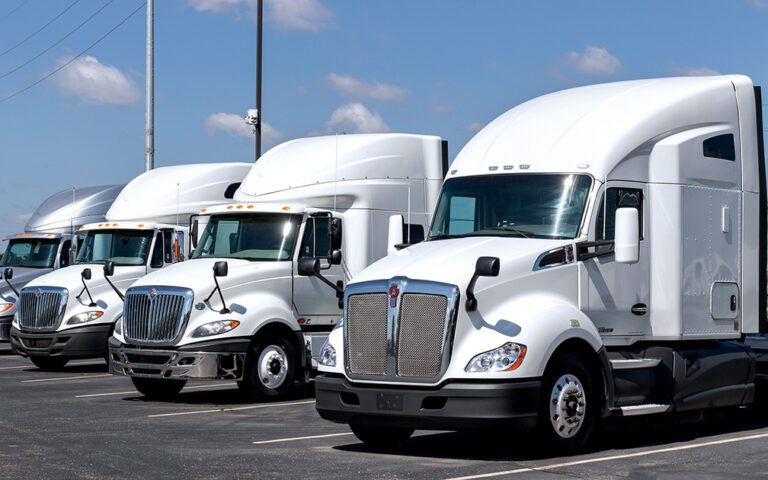The market for new Class 8 trucks in the U.S. continued to defy expectations in June, with manufacturers reporting sales of 24,085 units for the month.
Overall, June Class 8 sales on the U.S. market were just down 26 trucks from May sales of 24,111, according to data received from Wards Intelligence. Typically, the final month of a quarter is the strongest, but not this time. Regardless, if the current sales pace continues, it will top 271,600 for 2023, becoming the third-best year ever for Class 8 sales.
Industry analysts have been predicting a slowdown in Class 8 sales in the second half of 2023. Earlier this year, those same analysts were predicting a recession. At this point, it appears neither will happen — at least not to the degree many were looking for.
In its July “North American Commercial Vehicle Forecast,” ACT Research predicted higher sales and production volumes than in earlier reports.
“The upward forecast revisions reflect our view that macroeconomic positives will increasingly outweigh negatives as the calendar advances into 2024,” said Kenny Vieth, president and senior analyst at ACT. He cited consumer durables and capital equipment spending as two segments of the economy that have not experienced the declines predicted earlier in the year.
Another factor that has impacted freight levels and rates is “destocking.” Retailers and manufacturers tend to reduce their inventories of goods and parts to meet current sales numbers, and that’s been happening for the past six months or longer. The result is fewer orders to restock shelves and fewer trucks needed to haul the replacement products, contributing to rate declines.
“Next year inventory accumulation should inflect to a freight tailwind, from the current destocking headwind,” Vieth said. That’s an indication that freight might soon begin increasing.
One indicator of future Class 8 sales is the number of orders the industry is receiving. ACT reported 19,600 orders for new trucks in June, and that’s on the North American truck market. Obviously, if more than 24,000 trucks were sold on the U.S. market alone, orders aren’t keeping up. The backlog of trucks that were ordered and are yet to be built is steadily shrinking, but a large number of units remain to be built. There is also the closing of the books for the 2023 model year as manufacturers switch over to 2024 models.
“The relatively few build slots still free in 2H’23 suggest order intake is unlikely to find meaningful traction until 2024 order boards open,” said Eric Crawford, vice president and senior analyst at ACT. Typically, order boards for the next model year open in August or thereabouts.
Another truck sales factor looming on the horizon is the Environmental Protection Agency’s (EPA) emissions mandate for 2027 model year trucks. Tighter emissions standards are expected to drive new truck costs higher; this happened when previous mandates took effect. The trucking industry tends to respond by over-buying trucks in the year or two before the new, more efficient models are produced. ACT’s Vieth predicts truck dealers may purchase more trucks for stock in anticipation of customer demand, beginning as early as the first quarter of 2024.
FTR, another industry analyst, reported order activity for June was still below replacement demand.
“FTR has been anticipating net Class 8 orders to drop over the last several months to below 10,000 units. This has not occurred, which is a positive sign that fleets still need equipment,” said Eric Starks, chairman of the board for FTR. “With the recent solid order totals, it is all but guaranteed that Q4 production will be strong. OEM build slots for 2024 are not expected to open until August at the earliest.”
The slowdown in freight, without a commensurate slowdown in the production of new trucks, has also impacted the used Class 8 truck market. ACT reported used Class 8 retail sales in June were 24% higher than in June 2022, while the average price declined by 27% for the same period. That’s good news for truck shoppers on the used market. Those numbers are likely to continue for at least a few months, as freight levels and rates aren’t providing much incentive for buyers to part with their cash.
As for the individual OEMs, International is making a splash by regaining some of its former market position. In 2009, Navistar briefly topped Freightliner as the No. 1-selling brand in the U.S. Class 8 market with 28% of sales. Hard times, emissions issues and leadership changes, among other factors, brought the company to 11.1% of Class 8 sales in 2016.
With the acquisition of the company by the Traton Group, International’s share of the U.S. Class 8 market was up to 11.9% in 2021, grew to 12.5% in 2022 and currently sits at 14.1% for 2023, the second-highest share of the market of all manufacturers. June sales of 3,426 were up 6% from May’s 3,232 for Navistar and 17% from June 2022 sales of 2,927.
Freightliner continues to be the “big dog” in the Class 8 sales arena, reporting 8,991 sold for June — a decline of 4% from May but still 10.6% better than June 2022.
Kenworth sales of 3,512 were 9.8% better than 3,200 in May and 10% higher than June 2022. PACCAR sibling Peterbilt, with 3,243 reported trucks sold, saw a decline of 7.4% from May and a decline of 5.1% from June 2022. For the year to date, however, Peterbilt still holds the edge — 18,796 to Kenworth’s 18,719. Together, the companies are responsible for 27.6% of new Class 8 truck sales this year.
Volvo sales of 2,403 were down 2.8% from May, while sibling Mack’s tally of 1,744 was 10.9% better than May and 11.8% higher than June 2022.
Tesla is the new kid on the block, reporting sales of 30 Class 8 trucks in June. This brings Tesla’s 2023 total to 165. In addition, Hino reported sales of its first two Class 8 trucks of the year.
If freight rates are truly at the bottom, as is speculated by numerous outlets, demand for trucks will pick up as market conditions become more favorable.
Cliff Abbott is an experienced commercial vehicle driver and owner-operator who still holds a CDL in his home state of Alabama. In nearly 40 years in trucking, he’s been an instructor and trainer and has managed safety and recruiting operations for several carriers. Having never lost his love of the road, Cliff has written a book and hundreds of songs and has been writing for The Trucker for more than a decade.














